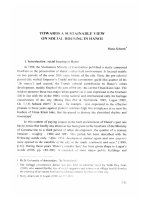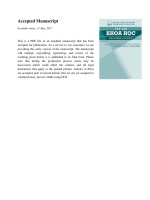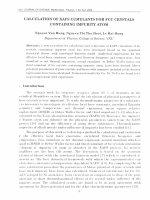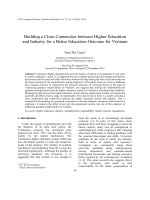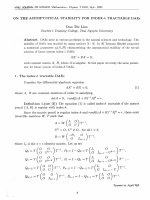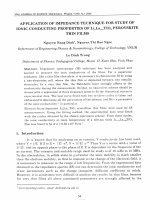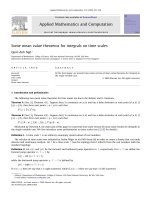DSpace at VNU: Ranking - A Useful Tool for University Governance
Bạn đang xem bản rút gọn của tài liệu. Xem và tải ngay bản đầy đủ của tài liệu tại đây (121.32 KB, 11 trang )
VNU Journal of Science, Vol. 31, No. 4 (2015) 10-20
Ranking - A Useful Tool for University Governance
Vũ Thị Mai Anh, Nguyễn Hữu Thành Chung,
Nguyễn Quý Thanh, Nguyễn Hữu Đức*
Vietnam National University, Hanoi, 144 Xuân Thủy, Cầu Giấy, Hanoi, Vietnam
Received 04 February 2015
Revised 15 July 2015; Accepted 20 December 2015
Abstract: Innovative management of higher education in Vietnam is supposed to be connected
with the mission and strategic governance. Practically, it is realized through the management of
core indicators concerning the education, research quality and the internationalized level. In this
case, the participation in the international university ranking leagues not only helps contribute to
the world higher education integration but also the university benchmark. However, this should be
performed in terms of the university mission. This paper focuses on the determinants of quality,
quality measurement and relationships between mission and quality, quality and ranking, ranking
and mission. In particular, in the epode of information society, innovative management is
efficiently supported by bibliometrics analysis. Vietnam National University, Hanoi can be
considered as a case study for this approach.
Keywords: Quality, mission, ranking, bibliometrics.
1. Introduction∗
throughout the country. Perhaps, the idea that
innovation of higher education should begin
with the innovation of management seems to be
paid much attention to and supported recently.
In this trend, innovative higher education
management is supposed to connect with the
governance of the university’s mission and
strategy and the use of university ranking as a
managerial tool for quality management in
coherence with university’s mission and strategy.
Every university states its mission which
addresses who that university is and what the
university does. From the mission statement,
the quality of university is reflected in the way
that university describes who they are (regular
or high standard institutions...) and how well
they do things (doing outstanding research,
providing high quality human resources...).
Higher education in Vietnam has been
developing rapidly in recent decades in terms of
the number of universities (public and private),
student population size, reducing the gap with
regional and international higher education,
contributing to the research outputs in the
region and the world over as well as the
country’s socio – economic development.
However, the quality and a long term strategic
development of Vietnam higher education are
still heated issues that should be urgently
solved. There are a lot of recommendations,
ideas and solutions relating to the development
of Vietnam’s higher education put forward by
many experts and scholars from different areas
_______
∗
Email:
10
V.T.M. Anh et al. / VNU Journal of Science, Vol. 31, No. 4 (2015) 10-20
Therefore, when a university prepares its own
mission, this also means that it defines what
quality would be addressed in the overall
activities. Vietnamese universities have their
own missions, which are reviewed after a
certain period to meet the requirements of the
country’s development and internationalization.
However, Vietnamese universities have been
facing two popular issues: (i) defining quality in
coherence with the mission and (ii) controlling
university’s activities in line with the mission.
Global university ranking is now knocking
the doors of all universities in all over the world
and they are likely to substantially influence the
long-term development of higher education
across the world (Marginson, 2007).
Universities in Vietnam have been paying more
attention to international university rankings.
Leading universities have set their strategic
goal to be one of the top 200 universities in
Asia and the top 500 universities in the world
by the prestigious world ranking tables.
Vietnam National University Hanoi (VNU –
Hanoi) is one of those. Playing the role of a
leading university in higher education in
Vietnam, VNU – Hanoi is the first higher
education institution to bring university ranking
experience and knowledge to higher education
in the country and one of few institutions to be
ranked by international ranking organisations.
Few years ago, while other Vietnamese
universities were approaching ranking as
observers, VNU – Hanoi already used ranking
results and ranking methodology as quality
assurance tools for benchmarking to improve
the whole quality of the institution to reach
international standards.
Improving university quality in accordance
with the university’s mission – the common
trend of global university rankings has been
considered as a goal and a tool for the
innovative
management
for
further
development in the internationalized context.
Over the last years, VNU – Hanoi has actively
and positively moved in that direction. This
paper will present some achievements and point
out certain experiences that may be useful for
11
other Vietnamese universities in their future
development.
2. University quality
2.1. Concept of quality
From early 1990s, higher education quality
has been paid much attention to and become an
important issue, received much debate (Harvey,
2006).
Quality in higher education is a
complex and controversial concept, which can
be seen from different approaches (academic,
teaching, learning, research...) and has been
described in different ways depending on the
purposes. Harvey (1995) identified five broad
approaches to define quality in higher
education: exceptional, perfection, fitness for
purpose, value for money, and transformation.
Fitness for purpose is the approach that is most
favoured by a number of institutions, agreed by
most of academics, promoted by a number of
stakeholders and fitness – for - purpose view of
quality that currently prevails may not be
surprising but is important nonetheless (Watty,
2006).
Since the ideas of total quality management
(Tenner and Detoro, 1992) and system
approach, Cheng (1995a) defined education
quality as follows: “Education quality is the
character of the set of elements in the input,
process, and output of the education system that
provides services that completely satisfy both
internal and external strategic constituencies by
meeting
their
explicit
and
implicit
expectations”. By that way, the concept of
education
quality
will
involve
the
characteristics of input, process, output and
multiple constituencies of an education
institution. This concept can support for the
fitness – for - purpose view of quality by
considering that a system of input, process and
output is set to facilitate the “purpose” of a
university; eventually, when purpose is
complete, all the stakeholders are satisfied.
Quality is also seen as procedure of
transformation to enhance and empower
12
V.T.M. Anh et al. / VNU Journal of Science, Vol. 31, No. 4 (2015) 10-20
students (Harvey & Knight, 1996). The
interrelationship
between
quality
and
transformation has been explored by empirical
research from the perception and experience of
academics and students (Cheng, M. 2014). Both
approaches on quality relate to quality of
student/graduate – “output” and academics –
faculty. When the purpose of a university is
clearly stated, then the quality of
student/graduate and academics is the
transformation to meet the purpose.
According to the British Quality Assurance
Agency – QAA (on its website) quality is
“academic quality”, thus: “A comprehensive
term referring to how, and how well,
institutions manage teaching and learning
opportunities to help students progress and
succeed”. In this concept, quality is a process of
teaching and learning management with results
being not only “students” but the contribution
of university management to achieve the quality
of students.
Brooks (2005)’s research on the university
quality measurement was based on the
definition of university quality which focuses
on three aspects, such as reputation, faculty
research, and student experiences (student
outcomes).
Gibbs (2010) adapted Biggs’s ‘3P’ model
(Biggs, 1993) to design dimensions of quality,
which is ‘presage’, ‘process’ and ‘product’.
Dimensions of presage are funding, staff:
student ratios, the quality of teaching staff and
the quality of students. These factors are the
inputs of a university. Process dimensions
include class size, class contact hours,
independent study hours and total hours, the
quality of teaching, the effects of the research
environment, the level of intellectual challenge
and student engagement, formative assessment
and feedback, reputation, peer quality ratings
and quality enhancement processes. And,
product dimensions consist of student
performance and degree classifications, student
retention and persistence.
WR Hume (2015) looks at university
quality with seven primary determinants:
mission, community of scholars, governance,
leadership,
management,
planning
and
evaluation and university activities (to fulfil the
mission). These seven determinants are also
indicators of many university rankings. Thus,
this approach can easily support the university
innovation of management by building strong
links between university mission, quality and
use of university ranking as a tool to implement
quality, improve quality. The following sections
will focus on quality with seven determinants of
WR Hume to measure and explore the
relationship between missions - quality; quality
- ranking; and mission – ranking.
2.2. Quality determinant
2.2.1. Mission
The mission of a university is what a
university wants to become and plans to be
(WR Hume, 2015). By that, university mission
statement is an important strategy and
communication element because mission would
present university purposes, scope of activities
and include principles, values which create
public image and motivate stakeholders. The
components of a university mission statement
are : industry, services, desired public image,
concern for satisfying customers/target
students, concern for employees, geographic
scope, values/philosophy, motivational message
of excellence or unique identity, benefit to
society,
distinctive
competence,
future
orientation, and academic objectives, activities
of organizations, it (the statement ?) includes
principles and values which create (Genç, K.
Y., 2012).
The mission plays the role as a managerial
tool which has the power of directing the
behaviour in companies. The development and
the existence of a mission statement and its
communication across and beyond companies’
borders might lead to an increase in companies’
performance (Dermol, V. 2012). Indeed, a
simple and good definition of quality in a
V.T.M. Anh et al. / VNU Journal of Science, Vol. 31, No. 4 (2015) 10-20
university is how well the mission is achieved
because the mission closely guides all
university decisions and actions to achieve the
purpose and complete the image that it wants to
be (WR Hume, 2015). When assessing a
university at a programme level, it is required
that “the programme reflects the vision and
mission of the university” (Criterion 3.2 of
AUN-QA standard, AUN-QA, 2011). Thus, a
mission should be persistent, applicable and can
also be reviewed in a certain period of time to
be sure it is suitable for the university and
community it serves.
Therefore, the mission is considered as the
first criterion of university quality. At the very
beginning, a university often determines and
states its mission, then transfers it into all of its
activities to accomplish their goals.
To measure a mission, it is qualitative rather
than quantitative. However, a well-structured
review can well judge the quality of both
process and outcome. Good accreditation
processes also seriously look at the mission; so
do well-structured quality assurance processes.
2.2.2. Community of scholars
Each university is a community of scholars,
including faculty, staff, students, graduates and
alumni. Faculty, staff, students directly involve
in academic activities such as researching,
teaching, community serving and many other
responsibilities that accompany these basic
functions to produce all of academic outputs
and achievements. These groups critically
decide performance and successes of a
university. The graduates and alumni are
products of a university, they are the ones who
best identify and support the institution for the
remaining of their lives. Moreover, because of
working in a broader community, alumni also
define and determine the reputation of the
institution in their domestic community and
beyond the border of their country.
Therefore, the quality of scholars’
community is contributed by the quality and
capacity of people who join the community,
therefore the quality of a university is
13
contributed by the quality of faculty, staff,
students, graduates and alumni.
The quality of students is measured by
student’s admission and students’ achievements
during their study. The proportion of
international students is also taken into account
when assessing quality of students by some
ranking organisations. In QS ranking
methodology, to assess a university for ranking,
the proportion of international students is one
indicator which takes 2.5% of the total score.
The quality of faculty and staff is measured
by their profile such as the proportion of staff
with Master’s degrees and faculty with PhD
degrees; the proportion of international faculty;
student/faculty ratio. The quality of faculty is
also measured by measuring their research
performance, such as the proportion of
publications per faculty; the number of Nobel
Prize and Fields Medal winners. In assessing
quality of university, especially academic
quality, quality of faculty and staff is the most
important indicator and take the main weight.
Indeed, in the ranking methodologies of many
ranking organisations, indicators related to
faculty take more weight than other indicators.
In the world ranking university methodology
2015 of AWRU1, the quality of faculty is
measured by a half of set of indicators (two
among four indicators) with 80% of the total
score.
The quality of graduates and alumni is often
measured by the proportion of their
employment and successes and even prizes they
get after graduates. That’s why in world ranking
university methodology 2015 of AWRU, the
quality of alumni is assessed by an indicator
which takes 10% of the total score: “Quality of
Education is measured by winning Nobel Prizes
and Fields Medals of alumni”.
2.2.3. Governance
Governance has become a major leverage
tool for improving quality in all aspects of
_______
1
/>
14
V.T.M. Anh et al. / VNU Journal of Science, Vol. 31, No. 4 (2015) 10-20
higher education (Henard & Mitterle, 2009) that
the leadership uses at the university with the
participation of all stakeholders to guide and
monitor the implementation of the university’s
objectives and mission. There are five elements
in university governance (Boer, Enders and
Schimank, 2007) such as State’s regulation,
stakeholder
guidance,
academic
selfgovernance and competition. University
governance also is faculty governance,
stakeholder governance, corporate governance,
trustee governance (Leon Trakman, 2008 in
Hénard & Mitterle, 2010). Whatever models
that an institutional applies, the participation of
stakeholders is important in governance.
Faculty participation is important in decisions
where faculty members have better information
and better incentives than administrators or
trustees (Brown Jr., William O. (1999).
Therefore, how strongly the community of
scholars participates in governance should be a
key determinant of quality.
However, a university is also influenced by
the input from external bodies and environment
such as external community, business, and
government. There is a fine balance between
linkage with external stakeholders, including
government; hearing and being responsive to
their point of view; and avoiding interference
by them in what the academic community does.
Thus, a strong role for the community of
scholars in governance helps to maintain that
balance. The culture of an institution and the
culture in which it operates will each influence
how governance structures operate and evolve.
The governance structure is designed for a
university to fulfil the mission, and then it
chooses and monitors leadership who operate
governance system by processes and tools.
The quality of governance is best measured
by reviews. Again, good institutional
accreditation and quality assurance processes
also evaluate that.
2.2.4. Leadership
Leadership can be defined as the process
that managers use to influence subordinates to
work toward organisational goals (Hirtz and
others, 2007). In another approach, leadership
at all levels is conceptualized as organisational
quality (Rodney & Steven, 1995). Therefore, it
can be said that, at a university, good leadership
can enhance quality but bad leadership can
damage it (WR Hume, 2015). Indeed, it is the
leadership that plays an important role for
quality management implementation (Edward
Demming,
1986).
Leadership
uses
management tools to guide all activities to
achieve the university’s mission, therefore
leadership decides on the successes of a
university. Leadership also contributes to the
development of the university culture. Thus, the
quality of a university such as achievements
and successes is the quality of leadership.
However, since being elected gives a leader
a lot of leverage, a lot of ability to change
things in the university. To have effective
university leadership requires clear delegation
of authority, and clear accountability
(WR Hume, 2015).
The quality of leadership is also best
measured by structured reviews of the
university vision, mission, achievements,
successes, behaviours, and assessments by staffs.
2.2.5. Management
University management can be based on
policy, delegation, accountability, budgeting,
and audit, rather than management by decrees.
Management quality can be measured by an
ongoing basis through institutional research
processes, ISO, quality assurance system,
accreditation with self-assessment and external
review tools.
2.2.6. Planning and evaluation
The duo of planning and evaluation are the
last general characteristics necessary for
enhancing university quality. The essential
underpinnings for quality, for success are
strong, ongoing, inclusive planning processes
with all the engagement and contribution of the
governance, leadership, and management chain,
and including the community of scholars.
Evaluation is necessary to give feedback
V.T.M. Anh et al. / VNU Journal of Science, Vol. 31, No. 4 (2015) 10-20
information
for
the
planning
and
implementation to go on the right track to meet
the goals and achieve the mission.
Planning and evaluation processes, which in
a sense are parts of good management. Good
and inclusive planning is also an essential part
of leadership.
2.2.7. Quality measurement
To measure and enhance university quality,
there are five mechanisms that university can
use. They are institutional research (IR),
reviews, accreditation, ranking, and selfassessment (a part of quality assurance). The
following focuses on using ranking to measure
quality by discussing the relevant relationship
between mission, quality and ranking, ranking.
3. Relationship between mission-quality-ranking
3.1. Mission and quality
As was mentioned above, the mission of a
university is what a university wants to become
and plans to be, thus an essential component of
defining a mission also is defining how
successes will be measured and a simple and
good definition of quality is how well the
mission is achieved.
Mission is a criterion for university quality
assessment. In Vietnamese quality standards for
higher education (Decision No 6, March 04,
2014 on promulgating regulations on standards
of education quality assessment), the 1st
standard is about the “university mission”. In
the mission, a university has to demonstrate that
it has a clear mission statement and this mission
must be well organised by all stakeholders of
the university.
In the quality standard of AUN–QA2, the
quality of education programme in a university
is assessed by how the mission is transferred
into education programmes at Standard 3;
Criterion 3.2 assesses how “the programme
reflects the vision and mission of the university”.
_______
2
Asian University Network – Quality Assurance.
15
Being one of the two leading universities in
Vietnam’s higher education VNU–Hanoi has its
mission as: “producing high quality human
resources and cultivating talents; promoting
advanced science, technology, renovation and
knowledge transfer; and playing the role of a
pioneer in Vietnam’s higher education reform.
This Mission is transferred into education
programmes and research development at
VNU-Hanoi. Over the last decades, a system of
quality assurance and advanced governance has
been developed in VNU-Hanoi in order t to
achieve its mission.
VNU-Hanoi’s mission is realized through
the quality which in its turn is determined by
the successes of graduates with high
employment rate; research outputs with high
publications in ISI and Scopus journals, good
citation and H index; increasing number of
successful innovations and knowledge transfers.
According to Scimago Lab, in recent years,
VNU–Hanoi is the leading university in
Vietnam in terms of research outputs (research
publications).
Therefore, mission implementation and
monitoring is an approach to develop and
assure the quality for all universities.
3.2. Quality and ranking
Ranking organisations have their own
ranking methodology to assess and rank
universities in the world by their quality in
certain areas or their overall activities. Ranking
methodology is a set of indicators to assess
quality and performance of universities which
may cover all of the university quality
determinants or just a part of them.
However, each ranking methodology may
focus on certain areas and some determinants of
success for universities which align well with
some ranking systems, but some do not.
AWRU3which assesses and ranks the world
universities by using six objective indicators
_______
3 Academic Ranking of World Universities, Shanghai Jiao
Tong University.
16
V.T.M. Anh et al. / VNU Journal of Science, Vol. 31, No. 4 (2015) 10-20
focuses more on academic performance,
including the number of alumni and staff
winning Nobel Prizes and Fields Medals,
number of highly cited researchers selected by
Thomson Reuters, number of articles published
in journals of Nature and Science, number of
articles indexed in Science Citation Index Expanded and Social Sciences Citation Index,
and per capita performance of a university;
Scimago Lab which assesses the world research
institutions focuses more on scientific
productivity, including Output, International
Collaboration, Normalized Impact, High
Quality Publications, Specialization Index,
Excellence Rate, Scientific Leadership,
Excellence with Leadership, Scientific talent
pool; while Quacquarrelli Symond (QS) tends
to assess universities more comprehensively
with indicators like academic reputation,
employer reputation, student-to-faculty ratio,
citations per faculty, international faculty ratio
& international student ratio.
Quality furthermore needs standards (Van
Kemenade et al, 2008), thus ranking indicators
can be used as standards and benchmarks for
universities to enhance quality and performance
to participate in the ranking or just to have
better quality.
VNU – Hanoi uses both ranking indicators
as quality standards and ranking results as
benchmarks to improve quality. Annually, QS
Asia ranking indicators are used as quality
standards for determining actual quality of all
areas (teaching, researching, services...), in
order to select areas for investment priority and
gradually improve quality of all areas. Besides,
VNU – Hanoi studies selected universities
among top 500 world or 200 regional
universities, study their performance and index
in research and teaching to do the
benchmarking with VNU – Hanoi’s
performance every year. From benchmarking,
the gap between the performance of VNU –
Hanoi and that of those universities would be
expolored, the low areas at VNU – Hanoi are
reveals
from
benchmarking.
Then,
benchmarking results are used as ones of the
important bases for annual academic planning
with quality improvement focus.
In 2013, from studying several higher
classifications
(Carnegie
Classification,
Amano's classification and research university
by Association of American Universities),
ranking methodologies (QS stars indicators,
SIR) and features of Vietnamese universities,
VNU – Hanoi has built “Research university
criteria” enclosed the guidance on assessing
institution’s performance annually. This is used
as a managerial tool for VNU – Hanoi to
promote member universities, institute and
research centers became research institutions by
benchmarking with this set of criteria. The
university criteria includes four main standards
with twenty nine criteria. They are, Research
performance and knowledge transference (500
score, 14 criteria); Teaching quality (400 score,
9 criteria); Internationalization (50 score, 3
criteria); and Infrastructure and facilities for
research and teaching (50 score, 3 criteria). In
the most important Standard, Research
performance and knowledge transference, the
main activities of a research higher education
institution are covered by fourteen criteria (see
the Table).
Each year, six VNU – Hanoi member
universities and three research institutes selfevaluate and specify their “low” areas that need
to be invested and improved and find out the
levels of research institution that they have
achieved by benchmarking using VNU
Research university criteria. Recently, the
evaluation on research university criteria of
2015 reveals three different groups by their
scores: Group 1 with VNU Hanoi University of
Science, VNU University of Social science and
Humanities
and
VNU
University
of
Engineering and Technology have reached 600
– 800 scores; Group 2 with VNU University of
Economics and Business, VNU Institute
Francophone
International
and
VNU
Information Technology Institute have reached
500 – 600 scores; and Group 3 with VNU
Hanoi
University
of
Languages
and
V.T.M. Anh et al. / VNU Journal of Science, Vol. 31, No. 4 (2015) 10-20
International Study, VNU University of
Education and VNU Institute of VNU Institute
of Vietnamese Studies and Development
Sciences have achieved 300 – 400 scores (over
total of 1000 scores). These results serve not
only as information for management in
17
monitoring the development of each member
institutions to be research institution but also a
potential basis to apply the higher education
stratification to VNU – Hanoi member
institutions in the future.
Table. Standard 1, Research performance and knowledge transference (from Guidance on Research University
Criteria, No 1206/HD-DBCLGD, Apr 23rd 2013)
Index
No
Standard/ Criteria
1
Average number of
publications national and
international journals per
academics annually
Number of publications
ISI and or/Scopus per
academics in latest 5 years
Number of
citation/publication in
latest 5 years
Reference books/year
2
3
4
5
6
7
8
9
Outstanding research
output at national and
international level
annually
Number of national or
international research
prizes of academics and
students in latest 5 years
Number of academics
have been invited to
present at national
research conference
annually
Number of academics
have been invited to
present at international
research conference
annually
Research and knowledge
transference and total
budget ratio/year
Weights
(Score)
0,5
VNU Hanoi 2015
(top 200 Asian
university)
1,0
20
≤ 5 publication (01
for social science)
0,3
0,5
80
At least 5
1,2
2,0
80
10
1-3/member
institution
20
10
< 1/member
institution
3/member university
(2 for social science;
institute, research
center)
1/ member university
(0,5/institute, research
center)
10
< 3/member
institution
≤2
/year/department,
discipline
< 1 paper/
institute,
research
center
≤ 1/
year/department,
discipline
< 0,3/
institute,
research
center
≤ 2 paper/ institute,
research center (0,5
for social science)
20
≤ 50% (25% for
social sciene)
20%
45%
60
Top 500 world
research university
VNU Hanoi
2013
≤2
≤ 5/ member
university (1/
institute, research
center)
≤ 2 paper/ institute,
research center
50
30
10
18
10
V.T.M. Anh et al. / VNU Journal of Science, Vol. 31, No. 4 (2015) 10-20
Research service
knowledge transference
and total research budget
ratio/year
Patents are is recognized
each year (Policy
consultation regarding
social science)
≤ 30% (15% for
social science)
5%
22,5%
10
≤ 5 international
patents, 20 national
patents
< 0,5
30
12
University – industry or
local collaboration/year
≤ 5 research
programme, project
<1
13
Knowledge
transference/year
<1
14
Academic reputation
05 research
programmes,
projects have been
transferred/year
≤ 75 positive
responses by survey
from rankings
≤1 national
patent/member
university (0,5 for
institute and research
center)
≤ 2/ member
university (1/ institute
and research center)
1/ member university
(0,5 for institute and
research center)
11
< 20/group
of
disciplines
50/group of
disciplines
20
20
50
* Member institutions including member university, institute, research center.
Being research-focused institution, VNU –
Hanoi has made a lot of efforts to improve the
quality and products of its research, one of
those is select proper ranking table as a tool.
VNU – Hanoi uses Scimago Institutional
Ranking (SIR) indicators as one way to enhance
its research quality among many others since
SIR focuses on research, innovation and web
visibility indicators to characterize world
institutions. SIR uses Scopus database
(Elsevier) to analyze and ranks the world
research institutions, therefore, VNU – Hanoi
encourages researchers to publish in not only
ISI but also Scopus journals. Then, every year,
VNU – Hanoi uses SIR indicators and results
for analyzing research output to assess the
effectiveness.
Besides, VNU – Hanoi also use
bibliometrics as an effective tool in renewing
the research management. VNU – Hanoi has
applied quantitative analysis and statistics to
analyze publications such as journal articles and
their citation counts to evaluate research
performance evaluation, and explore the impact
research field, the impact of a researcher of a
particular paper. By combining bibliometrics
with the benchmarks given by ranking result
study, research performance of an individual
researcher, a member university, a research
institute/centre of VNU as well as VNU –
Hanoi as a whole is assessed. Research
programmes and research projects at VNU –
Hanoi are also evaluated by bibliometrics, such
as number of publications published on ISI or
Scopus journals, the impact from those
publications (citations, paten cited from these
publication...)....
Then,
these
assessment/evaluation results are used for
annual research planning with investment
priorities, allocating funds to all levels in VNU
(researcher,
member
university...)...
Researchers and research groups at VNU –
Hanoi are also encouraged to use bibliometric
tool to evaluate international researchers in the
same research areas to look for research
partners and collaborations. By applying those
tools and innovation in research management,
VNU – Hanoi is the leading university in
Vietnam for research output assessed by SIR in
recent years.
The relationships between quality and
ranking are not simple, ranking helps with tools
that not only measure quality but also to
improve quality. In returns, when quality is
improved, the rank would also be improved.
V.T.M. Anh et al. / VNU Journal of Science, Vol. 31, No. 4 (2015) 10-20
3.3. Ranking and Mission
To best use ranking for achieving its goals
and mission, a university should select the
ranking system that aligns well with the
mission. Since a university’s mission is related
to stakeholders, it should make stakeholders
fully aware of the choice and the reasons to
choose that.
A university should have good management
on data of areas that contribute to measuring
quality as determinants discussed above.
Database is not only for the ranking
organisation(s) to allocate a university in the
world map but also for bibliometrics and other
management tools. Finally, after applying all
that mentioned above, to continue pursuing
ranking can be a very valuable contributor for a
university to improving quality.
VNU – Hanoi is a research-oriented
university which focuses on “promoting
advanced science, technology, renovation and
knowledge transference”. For the time being,
Scimago Institutions Rankings is our choice
because its main aim is to “characterize
research outcomes of organizations so as to
provide useful scientometric ranks to
institutions, policymakers and research
manager” to be “able to analyze, evaluate and
improve their research results”. A set of nine
indicators in research and two indicators in
innovation from SIR are used as our research
quality standards and also tools for evaluation
and measurement of research performance for
quality development.
4. Conclusion
Quality is important to universities in the
era of knowledge-based economy. When
ranking is now a common trend in higher
education in globalization context, the
innovative management at universities should
be approached from looking at quality, mission
and ranking in its relationship: mission–quality,
quality–ranking and ranking–mission with
support from analysed tools such as
19
bibliometrics. In that meaning, pursuing
ranking can be a very valuable contributor for
universities to improving their quality. VNU–
Hanoi has moved in that direction and has
recorded encouraging results especially in
research performance.
References
[1] Brooks,
Rachelle.
"Measuring
university
quality." The Review of Higher Education 29.1
(2005): 1-21.
[2] Brown Jr., William O. (1999), Faculty
Participation in University Governance and the
Effects on University Performance, Claremont
Colleges Working Papers in Economics, No.
1999-25.
[3] Cheng, Ming. "Quality as transformation:
educational metamorphosis." Quality in Higher
Education 20.3 (2014): 272-289.
[4] Claassen, Christopher. "Measuring university
quality." Scientometrics (2015): 1-15.
[5] Daraio, Cinzia, Andrea Bonaccorsi, and Léopold
Simar. "Rankings and university performance: a
conditional
multidimensional
approach." European Journal of Operational
Research 244.3 (2015): 918-930.
[6] Dermol, Valerij. "Relationship between mission
statement and company performance." Annals of
the
Alexandru
Ioan
Cuza
UniversityEconomics 59.1 (2012): 321-336.
[7] Deming, W. Edwards. "Out of Crisis, Centre for
Advanced Engineering Study."Massachusetts
Institute of Technology, Cambridge, MA (1986).
[8] Gibbs, Graham. Dimensions of quality. York:
Higher Education Academy, 2010.
[9] Genç, Kurtuluş Yılmaz. "The Relation between
the Quality of the Mission Statements and the
Performances of the State Universities in
Turkey."Procedia-Social
and
Behavioral
Sciences 58 (2012): 19-28.
[10] Harvey, L. & Knight, P.T., 1996, Transforming
higher education, (Buckingham, Society for
Research into Higher Education & Open
University Press).
[11] Henard F. and Mitterle, Governance and quality
guidelines in Higher Education” IMHE-OECD,
2009.
[12] Hénard, Fabrice, and Alexander Mitterle.
"Governance and quality guidelines in Higher
20
[13]
[14]
[15]
[16]
V.T.M. Anh et al. / VNU Journal of Science, Vol. 31, No. 4 (2015) 10-20
Education." A review of governance arrangements
and quality assurance. Berlim: OECD, 2010.
Hirtz, Paul D., Susan L. Murray, and Catherine A.
Riordan. "The effects of leadership on
quality." Engineering Management Journal 19.1
(2007): 22-27.
Marginson, Simon. "Global university rankings:
Implications in general and for Australia." Journal
of Higher Education Policy and Management 29.2
(2007): 131-142.
Rodney T. Ogawa and Steven T. Bossert,
“Leadership is as an organizational quality.
Educational Administration Quarterly, Vol. 31,
Mo. 2 (May 1995), 224 – 243.
Van Kemenade, Everard, Mike Pupius, and Teun
W. Hardjono. "More value to defining
[17]
[18]
[19]
[20]
[21]
quality." Quality in Higher Education 14.2
(2008): 175-185.
Watty, Kim. "Want to know about quality in
higher education? Ask an academic." Quality in
Higher Education 12.3 (2006): 291-301.
Warn, James, and Paul Tranter. "Measuring
quality in higher education: a competency
approach." Quality in Higher Education 7.3
(2001): 191-198.
Wyatt R.Hume, keynote presentation, QSMAPLE at
Qatar University Rankings
Conference, Doha, Qatar, May 6, 2015.
Aun – QA, Guide to AUN actual quality
assessment at programme level, 2011.
About Academic Ranking of World Universities
(8/2015)
/>
